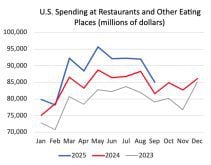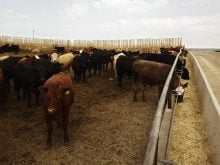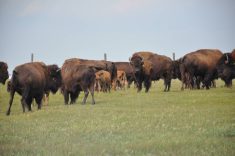Elanco’s Optaflexx, newly released for use in feedlots, is a feed additive backed up by extensive data that shows it increases carcass weight and yield and improves feed efficiency.
The label says it can be provided in the last 28 to 42 days of the feeding period.
The active ingredient is ractopamine hydrochloride, the same product found in Paylean, which is designed and labelled for hogs.
In Optaflexx, it comes in a different concentration designed and labelled for cattle.
Optaflexx is not a hormone or antibiotic and therefore has no withdrawal time requirements for slaughter.
Read Also

Trump’s tariffs take their toll on U.S. producers
U.S. farmers say Trump’s tariffs have been devastating for growers in that country.
It works by redirecting nutrients that would have become fat and increases muscle protein synthesis that builds muscle fibre, helping to increase lean meat yield.
It uses no more feed to do this, which is why the data points to a
12 to 16 percent increase in feed efficiency. In other words, the same amount of feed leads to more gain.
Those selling on a rail grade basis should note that 80 to 85 percent of the gain is in red meat yield, so the dressing percentage is increased. At today’s fed cattle prices, the extra income would be about $15 to $20 per head.
The gains are a little higher for steers than heifers.
The gains are offset by the cost of the product and the fact that it must be implemented into the feeding program for a short period. This pencils in at $7 to $8 per head.
When these costs are subtracted from the extra income, we get a net additional profit of $8 to $13 per head. These are fairly conservative estimates and there are variables that may result in even higher numbers.
Technically, Optaflexx should result in cattle getting to market quicker, which would also decrease yardage and other hidden costs.
In studies, Elanco varied the amount of product delivered and the length of time it was given. Most of the weight gain occurs in the first 28 days so that became the target length.
Two parts per million is the target concentration level.
These times and concentrations need to be worked out between a producer’s nutritionist and veterinarian.
Producers also need a written feed prescription for the product if they are including in the ration products such as rumensin, Tylan for liver abscesses and MGA to prevent heifers from cycling.
Because virtually all cattle in the feedlot are on rumensin or another ionophore, virtually all cattle on Optaflexx will need a prescription from the feedlot veterinarian.
Most of the gains occur in the first 28 days so users might want to start using it about 20 days before expected slaughter to provide flexibility in case cattle are held over a few days.
The logistic problem at the feedlot will be feeding all the pens together that need Optiflexx, which is why finishing lots are the only ones that will make use of this product.
Grade and quality of the finished product are paramount to the consumer. The company did controlled studies using taste tests and the Warner-Bratzler shear test, which is a quantitative, repeatable procedure that measures meat tenderness.
There was no tenderness difference between beef from cattle fed the product and those that were not.
In all other tests, grades did not change and there was no effect on meat taste, tenderness or juiciness.
These are important points when marketing. The United States and Japan have recognized this product as safe.
Because Canada exports so much of its beef, it is important that other countries recognize products such as Optiflexx.
More than 20 percent of U.S. cattle are finished on Optiflexx.
If you finish cattle, this product is worth discussing with your feedlot veterinarian and nutritionist to see how it may fit into your operation.
Roy Lewis is a veterinarian practising in Westlock, Alta.














